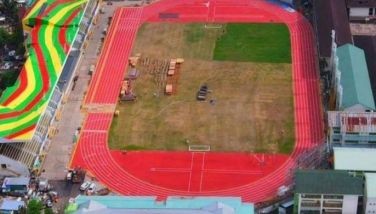Native Tree Of The Month: Narra
PART 1: Pterocarpus indicus
Physical Characteristics
Narra is a big tree, growing to 33 meters in height and two meters in diameter. The trunk is usually fluted and buttressed to seven meters diameter at the base. Narra bears many long branches that are at first ascending, but eventually arching over and sometimes drooping at the ends.
Its leaves bear about 12 alternate leaflets. The leaflets are rather large—about 7 x 3.5 to 11 x 55 centimeters—and ovate to elliptic in shape.
The flowers are small, yellow, fragrant and borne in large axillary panicles. When flowering, the buds do not open in daily sequence. Instead, as the buds come to full size, they are kept waiting, to be triggered into opening. The opened flowers last for one day. After that, several days may pass before another batch of accumulated “ready” buds open. Whole avenues of such trees, blooming in unpredictable synchrony make a splendid display.
The fruits, which take four months to mature, are disc-shaped, flat, and have winged margins. About five centimeters across, the fruit have a central woody-corky bulge containing several seeds. Unlike most legumes trees, the fruit is indehiscent and is dispersed by wind. It also floats in water and can be water-dispersed. There are 1-3 seeds in each fruit
Locations
Narra is found in primary and secondary forests at low and medium altitudes throughout the Philippines.
Methods of propagation
Narra can be propagated by seeds and cuttings. It grows best in open areas. Seedlings are slower in terms of growth than the cuttings. A strict culling program would be necessary to ensure that only the best stocks are planted out. Rooted cuttings can be established readily in nearly all kinds of soils, from coastal sands to inland clays, in urban and garden situations, and even in quite small planting holes dug into pavements. Few species can match narra in its ability to produce well-crowned instant trees within one or two years.
Traditional use
Bark and resin extracts is used to treat diarrhea while root extract is applied on syphilitic sores. The wood increases urination, cures diarrhea, and has anti-malarial properties.
The fruit kernel can induce vomiting.
The red latex is used in folk remedies for tumors and the plant for cancers, especially of the mouth. The kino obtained from this tree contains kinotannic acid and can be administered for diarrhea, often combined with opium. It is also used as a folk remedy for bladder ailments, dropsy, headache, sores, stones, thrush, and tumors of the abdomen.
The young leaves are applied on ripening boils, skin ulcers and prickly heat. Leaves soak on water relieves stomach trouble, sprue (a tropical disease affecting mouth, throat, and digestion), palpitation of the heart, rheumatism, abnormal mucous discharge from the vagina and fever.
Contemporary Use
The flowers are sources of honey. Although the wood is not necessarily recommended as firewood, it certainly could be used for firewood. Traditionally, it has so much in demand for cabinet class furniture that nearly everywhere its existence in the wild is precarious. In the Philippines, it is the national tree and the favorite timber for the manufacture of fine furniture, cabinetry, cart wheels, carving, construction, and musical instruments.
Leaves are used to make lotion, shampoo, disinfectant, and insecticide.
There is a distinctive sweet smell when working with the wood. It is little used for ornamental turning, but because the burl is so exquisitely figured, it makes a nice compliment to a piece to use it for finials or a cabochon-like inlay on a flat box top.
How to plant your narra seedling
Clear the area where you want to plant your seedling with unwanted weeds and debris. Make sure that a one-meter radius is kept free from other vegetation. Dig a plant hole with dimensions of at least 20cm x 20cm x 20cm. Plant the seedling at proper depth. Root collar should be at level with or a little below the ground surface with the seedling oriented upward. Fill the hole with top or garden soil and press soil firmly around the base of the seedling. In plantation-making, seedlings should maintain a two-meter distance between seedlings if planted in a row of a three-meter distance from one strip to the next strip.
How to take care of your narra seedling
Remove grass and other unwanted vegetation and cultivate the soil around the base of the seedling (50 cm radius) once in every quarter for two to three years. Place mulch around the base of the seedling (maintaining the 50 cm radius and using cut grass, leaves and other suitable materials as mulch base). Prune the branches at most 50 percent of the crown depth, preferably during dry season, and ensure that when pruning, you do not injure the bark. Remove infected or infested vegetation nearby to stop plant diseases from spreading and contaminating your seedling. Monitor regularly the growth of the seedling for presence of pests and diseases.
Data about native tree species are featured by the Ramon Aboitiz Foundation Inc. For suggestions, email [email protected].
WHY PLANT NATIVE TREES?
NATIVE TREES
a. They have high resistance to insect and disease attacks.
b. They create different layers of diverse, healthy, and thriving vegetation underneath the canopy, which reduce the tunnel effect of strong winds and double the ability of trees in erosion control.
c. Most insect predators such as bats, birds, predatory insects, and parasites build their homes on native trees.
d. They provide habitat for smaller animals and insect predators, which are important in the control of crop and pasture damaging pests, thereby reducing the use of pesticides.
e. By complementing the local landscape, they give an area a unique feel and provide a beautiful landscape.
f. They provide valuable resources for the survival of fauna species.
g. Some local animals are dependent on certain native trees to survive and/or thrive.
EXOTIC TREES
a. They increase the acidity of the soil, which prevents other plants to grow and multiply.
b. They are susceptible to diseases and can easily be ravaged by insects since they are not used to our environmental conditions,
c. They have lower wood density and shorter lifespan; therefore, they are not as effective as the premium native tree species when it comes to carbon sequestration.
d. The plant community underneath the canopy is not attractive and ecologically well-balanced because the wildlings of the exotic trees grow dominantly on its surroundings.
With the kind of ecosystem we have, native trees will bring back the forests the right way. (FREEMAN)
- Latest
- Trending






















